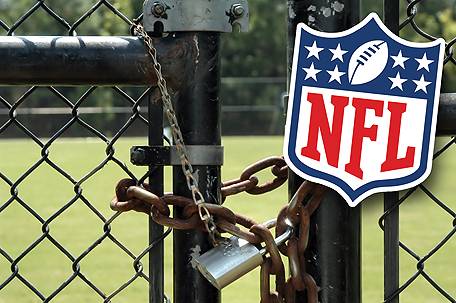
It looks as if the NFL lockout is just about over. The owners have approved a settlement and new 10-year collective bargaining agreement. Sounds like it time to break out the confetti right? Not so fast, the NFL Players Association has to re-certify and get the players to sign off on this new deal. It’s being said that the players aren’t happy with the deal as presented but have been painted into a corner by the owners.
Fact remains, we’re closer than we’ve been. I hope something can be worked out so we don’t lose any games. The estimated date that an agreement would need to be signed in order to prevent the loss of any preseason games is July 31st.
Until it’s all resolved, check out what the owners are proposing:
July 23 Waivers begin for the 2011 League Year.
July 24 Starting at 2:00 PM ET, clubs may begin to sign undrafted rookie free agents.
July 27 Expand rosters to 90-man limit.
August 11-15 First Preseason Weekend
August 12 Deadline for signing of Offer Sheets by Restricted Free Agents. (17-day period concludes)
August 18-22 Second Preseason Weekend.
August 25-28 Third Preseason Weekend.
August 26 Signing Period ends for Unrestricted Free Agents who received the June 1 Tender.
August 30 Clubs reduce rosters from 90 players to 75 players.
September 1-2 Fourth Preseason Weekend.
September 3 Clubs reduce rosters to 53 players.
September 8-12 First Regular-Season Weekend.
September 18-19 Second Regular-Season Weekend
- Reducing the off-season program by five weeks, reducing OTAs from 14 to 10;
- Limiting on-field practice time and contact;
- Limiting full-contact practices in the preseason and regular season;
- Increasing number of days off for players.
- Opportunity for current players to remain in the player medical plan for life.
- An enhanced injury protection benefit of up to $1 million of a player’s salary for the contract year after his injury and up to $500,000 in the second year after his injury.
- No change to the 16-4 season format until at least 2013; any subsequent increase in the number of regular-season games must be made by agreement with the NFL Players Association.
- $50 million per year joint fund for medical research, healthcare programs, and NFL Charities, including NFLPA-related charities.
- Over the next 10 years, additional funding for retiree benefits of between $900 million and $1 billion. The largest single amount, $620 million, will be used for a new “Legacy Fund,” which will be devoted to increasing pensions for pre-1993 retirees.
- Other improvements will be made to post-career medical options, the disability plan, the 88 Plan, career transition and degree completion programs, and the Player Care Plan.
- An annual Draft of seven rounds plus compensatory picks for teams which lose free agents.
- Unrestricted free agency for players after four accrued seasons; restricted free agency for players with three accrued seasons.
- Free agency exceptions (franchise and transition players).
ENTRY LEVEL COMPENSATION SYSTEM:
- All drafted players sign four-year contracts.
- Undrafted free agents sign three-year contracts.
- Maximum total compensation per draft class.
- Limited contract terms.
- Strong anti-holdout rules.
- Clubs have option to extend the contract of a first-round draftee for a fifth year, based on agreed-upon tender amounts.
- Salary cap plus benefits of $142.4 million per club in 2011 ($120.375 million for salary and bonus) and at least that amount in 2012 and 2013.
- Beginning in 2012, salary cap to be set based on a combined share of “all revenue,” a new model differentiated by revenue source with no expense reductions. Players will receive 55 percent of national media revenue, 45 percent of NFL Ventures revenue, and 40 percent of local club revenue.
- Beginning in 2012, annual “true up” to reflect revenue increases or decreases versus projections.
- Clubs receive credit for actual stadium investment and up to 1.5 percent of revenue each year.
- Player share must average at least 47 percent for the 10-year term of the agreement.
- League-wide commitment to cash spending of 99 percent of the cap in 2011 and 2012.
- For the 2013-2016 seasons, and again for the 2017-2020 seasons, the clubs collectively will commit to cash spending of at least 95 percent of the cap.
- Each club committed to cash spending of 89 percent of the cap from 2013-2016 and 2017-2020.
- Increases to minimum salaries of 10 percent in Year 1 with continuing increases each year of the agreement.
- Special transition rules to protect veteran players in 2011. All teams will have approximately $3.5 million in what would otherwise be performance-based pay available to fund veteran player salaries.
- Each club may “borrow” up to $3 million in cap room from a future year, which may be used to support veteran player costs.
- In 2012, each club may “borrow” up to $1.5 million in cap room from a future year. Both these amounts would be repaid in future years.



